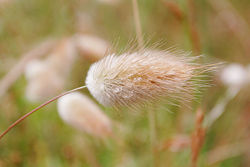Difference between revisions of "Grass" - New World Encyclopedia
m |
m (→What is Grass?) |
||
| Line 22: | Line 22: | ||
==What is Grass?== | ==What is Grass?== | ||
| + | Grasses, like orchids and palms, are monocotyledonous, having only one cotyledon, or embryo leaf, rather than the two found in most flowering plants. Most grasses grow low to the ground, although a few, such as corn, sugar cane, and bamboo, are very tall. | ||
Grasses generally have the following characteristics: | Grasses generally have the following characteristics: | ||
| − | * Typically hollow | + | * Typically hollow stems (called ''culms''), plugged at intervals (the ''nodes''). |
| − | * | + | * Leaves, arising at ''nodes'', alternate, ''distichous'' (in one plane) or rarely spiral, and parallel-veined. |
| − | * Leaves differentiated into a lower ''sheath'' hugging the stem for a distance and a ''blade'' with margin usually entire; a '' | + | * Leaves differentiated into a lower ''sheath'' hugging the stem for a distance and a ''blade'' with margin usually entire; a ''ligule'' (a membranous appendage or ring of hairs) lies at the junction between sheath and blade. |
| − | * Small, | + | * Small, wind-pollinated [[flower]]s (called ''florets'') sheathed inside two ''glumes'' (bracts), lacking petals, and grouped into ''spikelets'', these arranged in a ''panicle'', ''raceme'', ''spike'', or ''head''. |
| − | * [[Fruit]] that is a '' | + | * [[Fruit]] that is a ''caryopsis'', the seed and fruit merged together to form a hard dry grain. |
| − | + | Grass leaves grow from the base of the blade. This enables them to quickly regrow after being eaten by animals, or mowed by a lawn mower. | |
| − | |||
| − | |||
==Cultivation and uses== | ==Cultivation and uses== | ||
Revision as of 19:40, 20 May 2006
| True grasses | ||||||||||
|---|---|---|---|---|---|---|---|---|---|---|
| 240px Flowering head of Meadow Foxtail (Alopecurus pratensis), with stamens exserted at anthesis | ||||||||||
| Scientific classification | ||||||||||
| ||||||||||
| Subfamilies | ||||||||||
|
There are 7 subfamilies: |
The grass family, Poaceae, is one of the largest plant families, and to us humans perhaps the most important. There are about 600 genera and perhaps 10,000 species of grasses. It is estimated grasslands comprise 20% of the vegetation cover of the earth.
What is Grass?
Grasses, like orchids and palms, are monocotyledonous, having only one cotyledon, or embryo leaf, rather than the two found in most flowering plants. Most grasses grow low to the ground, although a few, such as corn, sugar cane, and bamboo, are very tall.
Grasses generally have the following characteristics:
- Typically hollow stems (called culms), plugged at intervals (the nodes).
- Leaves, arising at nodes, alternate, distichous (in one plane) or rarely spiral, and parallel-veined.
- Leaves differentiated into a lower sheath hugging the stem for a distance and a blade with margin usually entire; a ligule (a membranous appendage or ring of hairs) lies at the junction between sheath and blade.
- Small, wind-pollinated flowers (called florets) sheathed inside two glumes (bracts), lacking petals, and grouped into spikelets, these arranged in a panicle, raceme, spike, or head.
- Fruit that is a caryopsis, the seed and fruit merged together to form a hard dry grain.
Grass leaves grow from the base of the blade. This enables them to quickly regrow after being eaten by animals, or mowed by a lawn mower.
Cultivation and uses
Agricultural grasses grown for seed for human food production are called cereals. Cereals constitute the major source of food energy for humans and perhaps the major source of protein, and include rice in South and Southeast Asia, maize in Central and South America, and wheat and barley in the Americas and North Eurasia. Some other grasses are of major importance for foliage production. Sugarcane is the major source of sugar production. Many other grasses are grown for forage and fodder for animal food, particularly for sheep and cattle.
Grasses are used for construction; larger bamboos and Arundo donax have stout culms that can be used in a manner similar to timber, and grass roots stabilize the sod of sod houses. Arundo is used to make reeds for woodwind instruments, and bamboo is used for innumerable implements.
Grass fibre can be used for making paper, and for biofuel production. Grasses are the primary plant used in lawns, which themselves derive from grazed grasslands in Europe. Phragmites australis is important in water treatment, wetland habitat preservation and land reclamation in the Old World.
Some commonly known grass plants are:
See also

- agrostology
- grass
- sedges
- Meadow-grass
- Marram grass
- Bahia grass
- Brachypodium distachyon
External links and references
- Kew Index of World Grass Species
- Definitions of Grass structures
- Poaceae in L. Watson and M.J. Dallwitz] (1992 onwards). The families of flowering plants: descriptions, illustrations, identification, information retrieval.
- L. Watson and M. J. Dallwitz (1992 onwards). The grass genera of the world: descriptions, illustrations, identification, and information retrieval; including synonyms, morphology, anatomy, physiology, phytochemistry, cytology, classification, pathogens, world and local distribution, and references.
Credits
New World Encyclopedia writers and editors rewrote and completed the Wikipedia article in accordance with New World Encyclopedia standards. This article abides by terms of the Creative Commons CC-by-sa 3.0 License (CC-by-sa), which may be used and disseminated with proper attribution. Credit is due under the terms of this license that can reference both the New World Encyclopedia contributors and the selfless volunteer contributors of the Wikimedia Foundation. To cite this article click here for a list of acceptable citing formats.The history of earlier contributions by wikipedians is accessible to researchers here:
The history of this article since it was imported to New World Encyclopedia:
Note: Some restrictions may apply to use of individual images which are separately licensed.
